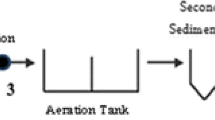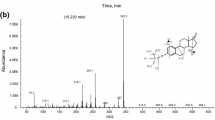Abstract
This paper presents the study of the occurrence of 10 endocrine-disrupting compounds (EDCs) in 60 water samples using a method for simultaneous quantification and confirmation of the presence of these emerging compounds, using ultra-performance liquid chromatography with electrospray ionization and tandem mass spectrometry (UPLC-ESI-MS/MS). All samples were previously extracted by solid-phase extraction (SPE). Several natural and synthetic hormones (17-β-estradiol, ethinylestradiol, estriol, estrone, progesterone, mestranol, and diethylstilbestrol) and some industrial products (4-n-nonylphenol, 4-tert-octylphenol, and bisphenol A) were chosen for this survey. The analytical limits were calculated for each compound and were used in the identification and quantification of these target compounds in EPAL’s water supply system. In this study, several samples were taken from the main intakes of water (surface and groundwater) used for production of water for human consumption and from different sampling points of the drinking water distribution system (piping, nets, and reservoirs). Some target compounds, such as estriol, 4-tert-octylphenol, mestranol, and nonylphenol, were found in trace amounts in several water samples. However, the studied endocrine-disrupting appeared in very low concentrations when compared with the assessed analytical limits.



Similar content being viewed by others
References
Bennie, D. T., Sullivan, C. A., Lee, H. B., Peart, T. E., & Maguire, R. J. (1997). Occurrence of alkylphenols and alkylphenol mono- and diethoxylates in natural water of Laurentian Great Lakes basin and the upper St. Lawrence River. Science of The Total Environment, 193, 263–275.
Boles, T. H., & Wells, M. J. M. (2010). Analysis of amphetamine and methamphetamine as emerging pollutants in wastewater and wastewater-impacted streams. Journal of Chromatography A, 1217, 2561–2568.
Carvalho, A.R.M. (2012). Monitoring of endocrine disruptors in water supply and WWTP by SPE-UPLC-ESI-MS/MS. EPAL. Master Degree Thesis in Environmental Engineering. Technical University of Lisbon. http://hdl.handle.net/10400.5/5371.
Céspedes, R., Lacorte, S., Petrovic, M., & Barceló, D. (2008). Occurrence and fate of alkylphenols and alkylphenol ethoxylates in sewage treatment plants and impact on receiving waters along the Ter River (Catalonia, NE Spain). Environmental Pollution, 153, 384–392.
Council Directive 98/83/EC of 3 November 1998 on the quality of water intended for human consumption. (1998). Official Journal L 330, pp 32–54 (ES, DA, DE, EL, EN, FR, IT, NL, PT, FI, SV).
Directive 2013/39/EU of the European Parliament and of the Council of 12 August 2013 amending Directives 2000/60/EC and 2008/105/EC as regards priority substances in the field of water policy (Text with EEA relevance). (2013). Official Journal L 226, pp 1–17 (BG, ES, CS, DA, DE, ET, EL, EN, FR, HR, IT, LV, LT, HU, MT, NL, PL, PT, RO, SK, SL, FI, SV).
Dolar, D., Gros, M., Rodriguez-Mozaz, S., Moreno, J., Comas, J., Rodriguez-Roda, I., & Barceló, D. (2012). Removal of emerging contaminants from municipal wastewater with an integrated membrane system, MBR-RO. Journal of Hazard Materials, 15(239–240), 64–9.
Esteban, S., Gorga, M., Petrovic, M., González-Alonso, S., Barceló, D., & Valcárcel, Y. (2014). Analysis and occurrence of endocrine-disrupting compounds and estrogenic activity in the surface waters of Central Spain. Science of the Total Environment, 466–46, 939–951.
Fredj, S. B., Nobbs, J., Tizaoui, C., & Monser, L. (2015). Removal of estrone (E1), 17β -estradiol (E2) and 17α-ethinylestradiol (EE2) from wastewater by liquid–liquid extraction. Chemical Engineering Journal, 262, 417–426.
Fuhrman, V. F., Tal, A., & Arnon, S. (2015). Why endocrine disrupting chemicals (EDCs) challenge traditional risk assessment and how to respond. Journal of Hazardous Materials, 286, 589–611.
Gorga, M., Insa, S., Petrovic, M., & Barceló, D. (2014). Occurrence and spatial distribution of EDCs and related compounds in waters and sediments of Iberian rivers. Science of The Total Environment, 503–504, 69–86.
Hohenblum, P., Gans, O., Moche, W., Scharf, S., & Lorbeer, G. (2004). Monitoring of selected estrogenic hormones and industrial chemicals in groundwaters and surface waters in Austria. Science of The Total Environment, 333, 185–193.
Kasprzyk-Hordern, B., Dinsdale, R. M., & Guwy, A. J. (2008). The occurrence of pharmaceuticals, personal care products, endocrine disruptors and ilicit drugs in surface water in South Wales, UK. Water Research, 42(13), 3498–3518.
Kolpin, D. W., Furlong, E. T., Meyer, M. T., Thurman, E. M., Zaugg, S. D., Barber, L. B., Buxton, H. T. (2002). Pharmaceuticals, hormones and other organic wastewater contaminants in U.S. streams 1999-2000: a national reconnaissance. Environmental Science Technology, 36(6), 1020–1211.
Kosjek, T., Heath, E., & Krbavčič, A. (2005). Determination of non-steroidal anti-inflammatory drug (NSAIDs) residues in water samples. Environment International, 31, 679–685.
López-Roldán, R., Alda, M. L., Gros, M., Petrovic, M., Martin-Alonso, J., & Barceló, D. (2010). Advanced monitoring of pharmaceuticals and estrogens in the Llobregat River basin (Spain) by liquid chromatography-triple quadrupole-tandem mass spectrometry in combination with ultra performance liquid chromatography-time of flight-mass spectrometry. Chemosphere, 80, 1337–1344.
ME 72 (2010). Determinação quantitativa de desreguladores endócrinos - Método de Cromatografia de Ultra Resolução associada à espectrometria de massas. Internal method from EPAL.
Penetra, A., Cardoso, V., Ferreira, E., & Benoliel, M. (2010). Solid-phase extraction and gas chromatography-tandem mass spectrometry method for the simultaneous determination of several pesticides in water. Water Science and Technology, 62(3), 667–675.
San Filippo, K., Pinto, B., Colombini, M. P., Bartolucci, U., & Reali, D. (2010). Determination of trace endocrine disruptors in ultrapure water for laboratory use by the yeast estrogen screen (YES) and chemical analysis (GC/MS). Journal of Chromatography B, 878, 1190–4.
Sebők, Á., Vasanits-Zsigrai, A., Helenkár, A., Záray, G., & Molnár-Perl, I. (2009). Multiresidue analysis of pollutants as their trimethylsilyl derivatives, by gas chromatography–mass spectrometry. Journal Chromatography A, 1216, 2288–2301.
Stanford, B. D., & Weinberg, H. S. (2007). Isotope dilution for quantification of steroid estrogens and nonylphenols by gas chromatographic with tandem mass spectrometry in septic, soil and groundwater matrices. Journal of Chromatography A, 1176, 26–36.
Compliance with ethical standards
I testify on behalf of all co-authors that regarding our paper submitted to Environmental Monitoring and Assessment:
The manuscript has not been submitted to more than one journal for simultaneous consideration.
The manuscript has not been published previously (partly or in full), unless the new work concerns an expansion of previous work (please provide transparency on the re-use of material to avoid the hint of text-recycling (“self-plagiarism”)).
A single study is not split up into several parts to increase the quantity of submissions and submitted to various journals or to one journal over time (e.g., “salami-publishing”).
No data have been fabricated or manipulated (including images) to support your conclusions
No data, text, or theories by others are presented as if they were the author’s own (“plagiarism”). Proper acknowledgements to other works must be given (this includes material that is closely copied (near verbatim), summarized and/or paraphrased), quotation marks are used for verbatim copying of material, and permissions are secured for material that is copyrighted.
Consent to submit has been received explicitly from all co-authors, as well as from the responsible authorities—tacitly or explicitly—at the institute/organization where the work has been carried out, before the work is submitted.
Authors whose names appear on the submission have contributed sufficiently to the scientific work and therefore share collective responsibility and accountability for the results.
Author information
Authors and Affiliations
Corresponding author
Rights and permissions
About this article
Cite this article
Carvalho, A.R.M., Cardoso, V.V., Rodrigues, A. et al. Occurrence and analysis of endocrine-disrupting compounds in a water supply system. Environ Monit Assess 187, 139 (2015). https://doi.org/10.1007/s10661-015-4374-0
Received:
Accepted:
Published:
DOI: https://doi.org/10.1007/s10661-015-4374-0




